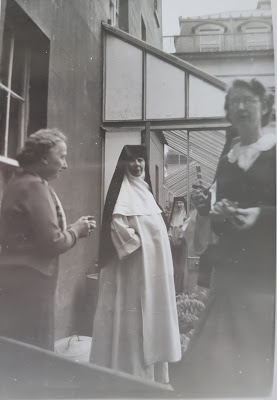1916 and a sister's private grief: Seán Heuston's execution and Galway
In the little cemetery attached to the Dominican Convent at Taylor’s Hill, a black cross standing under the shade of an elm tree indicates the remains of Mother Bernard Heuston, O.P. Bernard (christened Mary), was the older sister of Seán Heuston, one of the executed leaders of the Easter Rising. Mary was born in Dublin in 1889; she entered the enclosed Dominican Monastery at Galway in 1914, where she made her religious profession at the age of 26 in 1915. She died April 21, 1960. Before entering the religious life, Mary was trained as a teacher in King Inns Street near Dominick Street where the family then lived. The Heustons later moved to nearby 20 Fontenoy Street.
As an enclosed nun, Sr. Mary’s receiving the news of her younger brother’s execution, naturally may have been accentuated by a sense of helplessness and frustration at not being able to attend his funeral. Her community noted at the time however, that she accepted the tragedy of the cross she bore with quiet dignity and resignation; never referring to the matter of her famous brother’s death. The Dominican friars at Dominic Street (Dublin) evidently played a significant role in the upbringing of the Heuston household, particularly after the departure of their father to England. Mrs. Maria Heuston and all of her offspring were third order (tertiary) Dominicans. Indeed, Mrs. Heuston had wished that her son Jack (Seán) might be buried in the Dominican habit on hearing word of his ensuing execution. The young revolutionary however, insisted on being interred in his own military garb.
 |
| Mother Bernard Heuston (centre) with her sister Teresa (left) at the Domincan Convent, Taylor's Hill, Galway. |
The ‘Sunday night’ referred to by Browne was May 7 of 1916, the night before Seán Heuston’s execution. On the same day, Heuston wrote his last letter to his sister in Galway. The rebel pleaded with his eldest sibling to ‘teach the children the History of their own land and to teach them [that] the cause of Caitlín Ní hUallacháin never dies.’ In the same letter, the condemned revolutionary also expressed his concern for their mother, who was by then financially dependent on him, ‘Poor mother will miss me, but I feel, with God’s help, she will manage. You know the Irish proverb’ he continues, ‘God’s help is nearer than the door’.
 |
| A young Sean Heuston, pictured in Limerick (n.d) |
By T.P.L., graduate of the school of history at U.C.G., and former pupil of both Mother Bernard at the Dominican College at Taylor’s Hill and Prof. Donavan O’Sullivan at U.C.G.
The Exhibition "A University in War and Revolution - The Galway Experience 1913-1919 is open daily at the Hardiman Research Building, NUI Galway and admission is free.

Comments